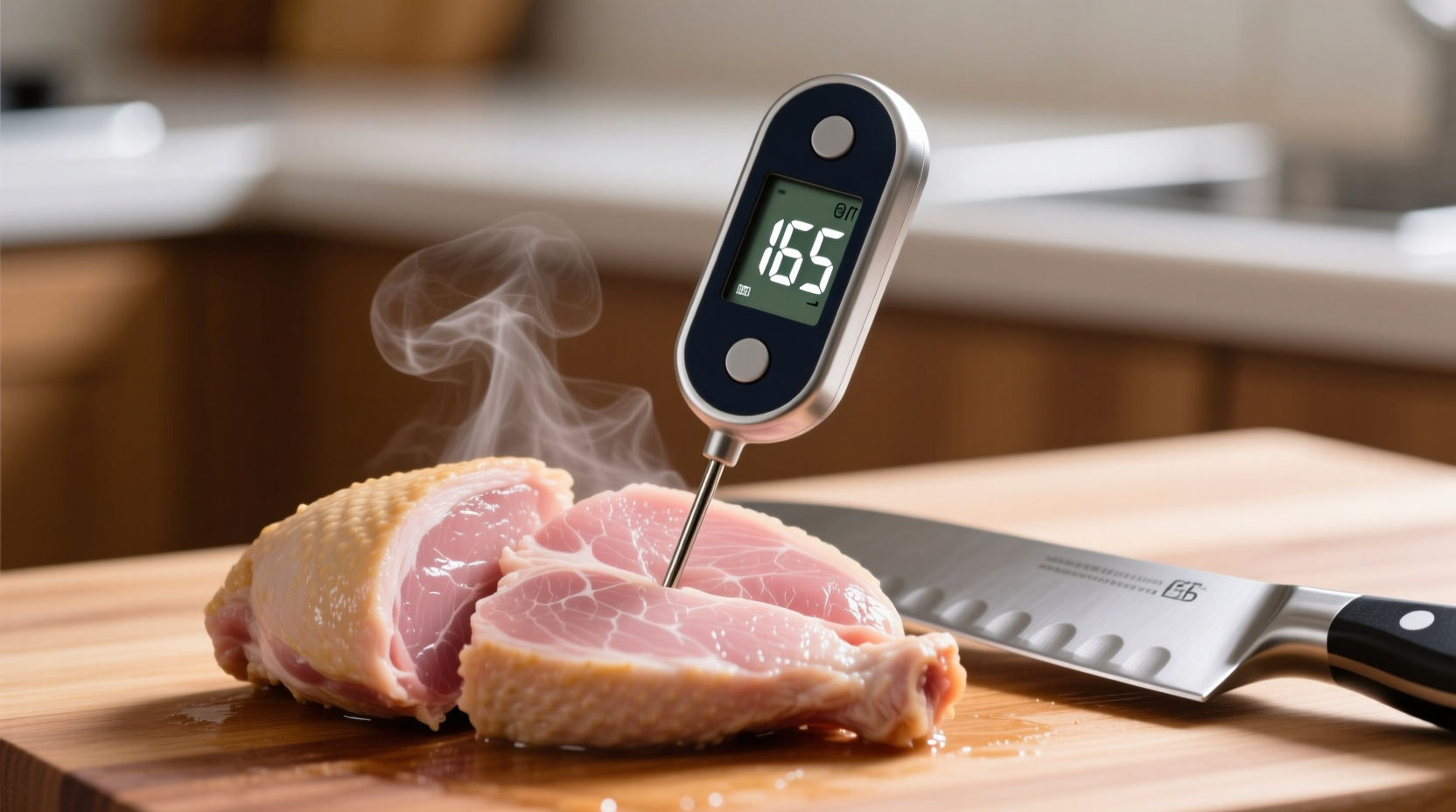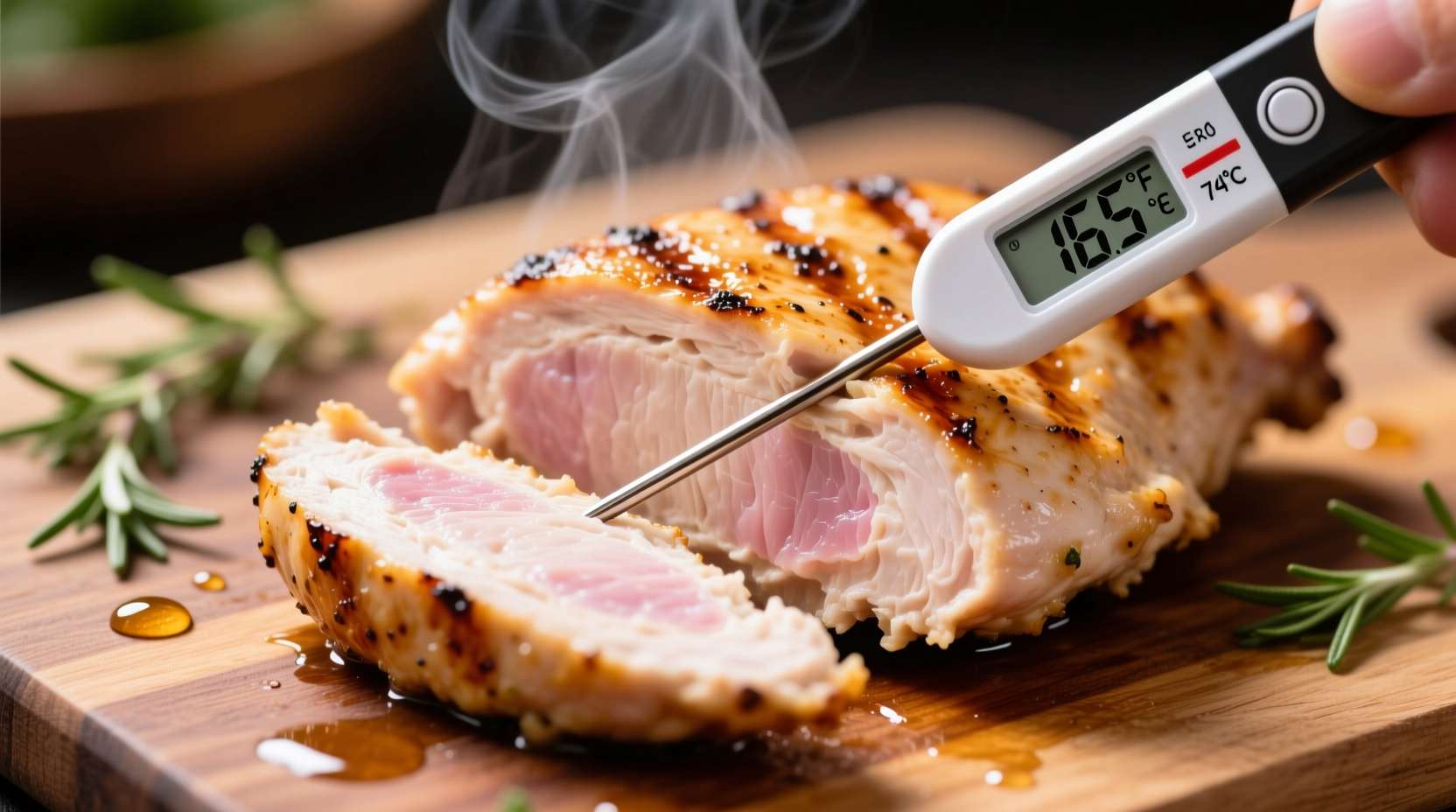The safe internal temperature for fully cooked chicken is 165°F (74°C) according to the USDA Food Safety and Inspection Service. This temperature destroys harmful bacteria like salmonella and campylobacter that can cause foodborne illness. Always verify with a food thermometer inserted into the thickest part of the meat, avoiding bone.
Why 165°F Is the Gold Standard for Chicken Safety
Understanding why precise temperature matters transforms how you approach poultry preparation. When chicken reaches 165°F (74°C), it eliminates dangerous pathogens in less than one second. This critical threshold isn't arbitrary—it's based on extensive food safety research from the USDA's Food Safety and Inspection Service.
Many home cooks operate under dangerous misconceptions. Chicken isn't safe when juices run clear (which happens around 150°F) or when it's no longer pink (which can persist up to 160°F). Only a calibrated thermometer provides certainty. The Centers for Disease Control and Prevention reports that undercooked poultry causes approximately 1 million foodborne illnesses annually in the United States alone.
Mastering Temperature Verification: Your Step-by-Step Guide
Proper thermometer technique separates safe meals from risky ones. Follow these professional kitchen practices:
- Choose the right tool: Use an instant-read digital thermometer (like Thermapen) for accuracy within ±0.5°F
- Target the thickest section: Insert probe into deepest part of breast or thigh, avoiding bone which conducts heat differently
- Check multiple spots: Especially with larger cuts like whole birds, verify temperature in several locations
- Wait for stabilization: Hold thermometer in place until reading stops climbing (about 10-15 seconds)
- Sanitize between uses: Clean probe with alcohol wipes when checking different meats
Temperature Variations Across Chicken Cuts
While 165°F remains the universal safety standard, different cuts require distinct approaches to achieve optimal texture without compromising safety:
| Chicken Cut | Safe Minimum Temp | Recommended Rest Temp | Texture Result |
|---|---|---|---|
| Breast | 165°F (74°C) | 160°F (71°C) | Juicy without dryness |
| Thighs/Drumsticks | 165°F (74°C) | 175°F (79°C) | Tender, connective tissue dissolved |
| Ground Chicken | 165°F (74°C) | 165°F (74°C) | Safe, no pink remaining |
| Whole Chicken | 165°F (74°C) | 160°F (71°C) | Moist breast, tender dark meat |
Note that dark meat can safely reach up to 175°F for optimal texture as its higher fat content protects against drying out, while breast meat becomes dry beyond 165°F. The USDA's Chicken and Food Safety guidelines confirm that all poultry must reach 165°F for safety regardless of cut.
Common Temperature Mistakes Home Cooks Make
Even experienced cooks fall victim to these temperature pitfalls:
- The Visual Trap: Judging doneness by color or clear juices (pink tinge can persist in safely cooked chicken due to myoglobin)
- Thermometer Misplacement: Inserting too close to bone or near cavity air pockets
- Resting Negligence: Not accounting for 3-5°F temperature rise during resting period
- Cross-Contamination: Using same thermometer for raw and cooked meat without sanitizing
Professional kitchens follow the "two-point rule": verify temperature in two different locations on larger cuts. The FDA Food Code specifies that temperature verification must occur in the geometric center of the thickest portion for accurate readings.

When Lower Temperatures Might Be Acceptable (With Caveats)
Advanced cooking techniques like sous vide allow for lower temperatures with extended time, but require precise control:
- Sous vide method: 145°F (63°C) for 30+ minutes destroys pathogens through time-temperature synergy
- Restaurant exception: Some establishments cook breast to 150°F with immediate sear, but this carries higher risk
The USDA maintains that 165°F remains the only universally safe recommendation for home cooks. The CDC explicitly warns that home kitchens lack the controlled environments needed for alternative temperature protocols. For vulnerable populations (children, elderly, immunocompromised), strict adherence to 165°F is non-negotiable.
Practical Temperature Management Tips
Implement these professional techniques for consistently safe, delicious chicken:
- Preheat your thermometer: Insert into hot water for 30 seconds before use for faster readings
- Check early and often: Begin temperature checks 5-7 minutes before expected doneness
- Rest properly: Tent with foil and rest 5-10 minutes (breasts) or 10-15 minutes (whole birds)
- Calibrate monthly: Use ice water (32°F/0°C) or boiling water (212°F/100°C) test
Remember that carryover cooking continues to raise internal temperature 3-5°F during resting. Remove chicken from heat at 160-162°F to reach the target 165°F after resting. The National Chicken Council confirms that properly rested chicken maintains safety while achieving superior texture.
Final Safety Verification Checklist
Before serving chicken, complete this quick safety verification:
- Thermometer registers 165°F in thickest part
- No pink color remains in juices when pierced
- Meat feels firm, not rubbery or jiggly
- Thermometer sanitized after final reading
- Leftovers cooled and refrigerated within 2 hours
Frequently Asked Questions
Is chicken safe at 160 degrees Fahrenheit?
Chicken reaches safety at 165°F (74°C), not 160°F. At 160°F, harmful bacteria like salmonella may still survive. The USDA specifies 165°F as the minimum safe temperature because it destroys pathogens instantly. While some professional chefs pull chicken at 160°F accounting for carryover cooking, home cooks should verify 165°F for absolute safety.
How long after reaching 165°F should I let chicken rest?
Rest chicken for 5-10 minutes after reaching 165°F. Breast meat requires 5-7 minutes while whole birds need 10-15 minutes. Resting allows juices to redistribute and temperature to stabilize, preventing dryness. Never skip resting, as it completes the cooking process and ensures food safety by maintaining lethal temperatures for pathogens during this period.
Can I rely on color to determine if chicken is cooked?
No, color alone cannot verify chicken safety. Pink tinge may persist in properly cooked chicken due to myoglobin reaction, while fully cooked chicken can sometimes appear white yet remain unsafe. The USDA confirms that visual indicators are unreliable—only a food thermometer provides accurate safety verification at 165°F (74°C).
What's the danger zone for chicken temperature?
Chicken enters the danger zone between 40°F and 140°F, where bacteria multiply rapidly. Within this range, pathogens can double every 20 minutes. The critical risk zone is 70°F to 125°F. Always keep raw chicken refrigerated below 40°F and cook it rapidly through the danger zone to reach 165°F for safety. Never let cooked chicken sit in the danger zone for more than 2 hours (1 hour if above 90°F).











 浙公网安备
33010002000092号
浙公网安备
33010002000092号 浙B2-20120091-4
浙B2-20120091-4